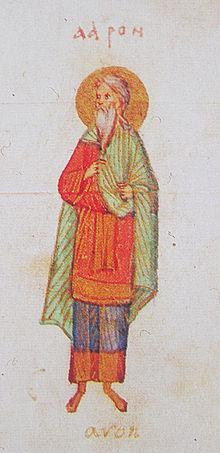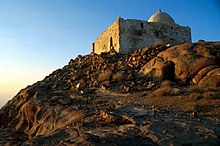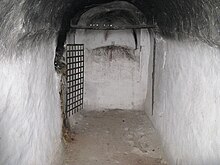Aaron (biblical person)
Aaron ( Hebrew אַהֲרֹן Aharon ; Arabic هارون Harun , possibly from Egyptian '3 rn "great is the name (of God)" or by changing the sound from l to r from Hebrew אַהֲלוֹן, ahǎlôn "tent man" or from Hebrew ארון Aron "ark, box") is according to biblical tradition ( 2nd book of Moses ) the older brother of Moses and first high priest of the Israelites. The sister of the two was Mirjam .
Aaron was the son of Amram and Jochebed , from the tribe of Levi and three years older than Moses, whose spokesman (biblical "mouth, prophet"; Ex 4.14 EU ; 7.1 EU ) he was involved in the Israelite work of liberation and legislation was.
Biblical tradition
Aaron was given the hereditary office of high priest ( Aaronic priesthood ) by Moses on behalf of their God ( Ex 29 EU ). Representatives of the twelve tribes of Israel had according to the Book of Exodus twelve bars on the ark set. The fact that only Aaron's rod was green (the botanical name Aronstab is derived from this incident ) was considered a sign of his election ( Num 17 EU ). Aaron violated the dignity of his office on Mount Sinai by making the golden calf and by revolting against Moses ( Num. 12.1 EU ).
With his wife Elischeba , a daughter of Amminadab , he was the father of Nadab , Abihu , Eleazar and Itamar ( Ex 6.23 EU ). According to Lev 10.1 EU, the first two died an unnatural death when they tried to worship God in a ritual they had invented instead of the one given by God. Since according to Num 20.12 EU and Num 20.24 EU both brothers, Aaron and Moses, disregarded God's instruction in the last year of the Exodus at the “water of Meriba”, God did not allow either of them to enter the “Promised Land” of Canaan .
Aaron died on the way to the land of Edom on Mount Hor . Moses installed Aaron's son Eleazar as his successor as high priest , who had accompanied him on the way to the mountain. The mountain Hor is known today as Jabal Harun , so it is named after the Arabic spelling of Aaron . There, a little south of the rock city of Petra in Jordan , you can visit the place that, according to tradition, is supposed to be Aaron's grave.
Aaron in Islam
As Harun , Aaron is one of the prophets of Islam ( Koran , Sura 19:51). According to biblical tradition, he is Musa's brother ( Moses ) and Imran's son ( Amram ). In sura 7,141 he is referred to as Musa's caliph (representative). According to Islamic tradition, he was sent by Allah to the people of the Jews in Israel to proclaim his message, namely to serve no god except Allah and not associate anyone with him, and only to do what is good and not to harm people.
In contrast to the biblical representation, Aaron is not presented in the Koran as a seducer of the Israelites. The builder of the golden calf there is a Samaritan ( as-Sāmirī ). When Moses returns after his communion with God on Mount Sinai , however, he is angry that Aaron has not renounced the children of Israel. Instead he stayed to remind them of the right faith and that he is the leader ( al-amīr ) in Moses' absence ( sura 20 , 92-94).
He is venerated as the holy Nabi Harun . His Qubba (Islamic grave building) with the grave cave underneath on the summit of the 1400 meter high Jabal Harun is a destination for pilgrims who hope to be cured of their illnesses.
Aaron in art
In the visual arts, Aaron often appears as a minor character in illustrations of the Moses story. He usually wears the robe of a Jewish high priest, on medieval depictions also that of a bishop. He is often depicted with the censer . The headgear appointed by Moses to the high priest brother Aaron was to Moses, according to the second 39.27-28 ( ex 39.27-28 EU ) high hat made of fine linen be a woven from Steckmuschel wool silk, it is often as a transversely disposed "Horns - Mitra "reproduced. A typical attribute is the breastplate set with 12 precious stones. Baroque representations follow more literally the traditions of the clothing of the high priest in the Old Testament.
In the Middle Ages, Aaron was also counted among the prophets and heralds of the virginity of Mary . In Marian symbolism , it was especially Aaron's wand miracle that was seen as a model for the virgin birth . For example, on the baptismal font of Hildesheim Cathedral from around 1230, you can see Aaron with a green stick between eleven dry sticks. As an Old Testament figure, Aaron also plays a role in the illustrations of the typological manuscripts Concordia caritatis by Ulrich von Lilienfeld , Poor Bible and Salvation Mirror .
The Austrian composer Arnold Schönberg wrote an unfinished opera Moses and Aron , which deals with biblical material. A central theme is the juxtaposition of the eloquent but ethically immature Aaron and the godly but rhetorically awkward Moses. The opera was made into a film by the French directors Straub-Huillet . The third act that Schoenberg did not set to music was reproduced in spoken chant.
The Aaronites
According to Old Testament Jewish tradition, a descendant of Aaron was at the head of the priests and thus the sanctuary, according to post-exilic clarification from the line Aaron> Eleazar> Pinchas and finally> Zadok ("righteous"), who is considered the first high priest at the temple of Solomon (ancestor of the priestly family of the Zadocids).
The priestly descendants of Aaron as the first high priest are called the Aaronites ( aroˈniːtn̩ ) or Kohanim . Only the descendants of the Aarons family from the Levi tribe had the authority to perform the service in the tabernacle (later in the Jerusalem temple ) ( Ex 28.1 EU ). According to scientifically controversial genetic studies on the Kohanim, a relationship can be traced back to a historical person via the Y chromosome of the Aaronites , as whom the biblical Aaron is identified.
See also
- Aaronic blessing
- Aaron's staff (Bible)
- Arum (plant genus) and arum family
literature
- Kurt Hennig (Ed.): Jerusalem Bibellexikon . Hänssler-Verlag, Neuhausen-Stuttgart 1990, ISBN 3-7751-2367-9 .
- Aelred Cody, Michael Brocke : Aaron / Aaronic Priesthood I. In the Old Testament II. In Judaism . In: Theologische Realenzyklopädie (TRE). Volume 1, de Gruyter, Berlin / New York 1977, ISBN 3-11-006944-X , pp. 1-7.
- Heinrich Valentin: Aaron. A study of the pre-priestly Aaron tradition. OBO 18. Friborg / Göttingen 1978.
- Karl Möller: Aaron. In: Real Lexicon on German Art History. Volume I. 1933, Col. 6-11; also digitally in: RDK Labor [accessed June 19, 2019].
Web links
- Klaus Koenen: Aaron / Aaroniden. In: Michaela Bauks, Klaus Koenen, Stefan Alkier (eds.): The scientific biblical dictionary on the Internet (WiBiLex), Stuttgart 2006 ff., Accessed on April 5, 2012.
- Aaron in the index of the art historical picture archive Foto Marburg (selection)
- Aaron in the index of the picture archive at the Rijksbureau voor Kunsthistorische Documentatie
Individual evidence
- ^ K. Koenen: Aaron / Aaroniden. In: Michaela Bauks, Klaus Koenen, Stefan Alkier (Eds.): The Scientific Biblical Lexicon on the Internet (WiBiLex), Stuttgart 2006 ff.


